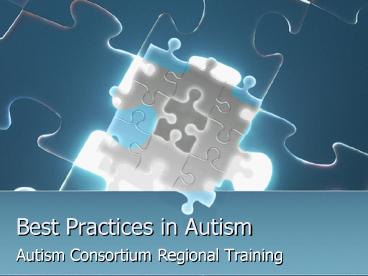Best Practices in Autism - PowerPoint PPT Presentation
1 / 26
Title:
Best Practices in Autism
Description:
will increase the student's competent performance Dunlap & Robbins, 1991. Comprehensive ... Dunlap, 1999. Family Involvement. Communication with families ... – PowerPoint PPT presentation
Number of Views:16
Avg rating:3.0/5.0
Title: Best Practices in Autism
1
Best Practices in Autism
- Autism Consortium Regional Training
2
Roadmap
- Quick Facts
- 6 Essential Themes
- Putting it Together
3
Quick Facts
- According to the Center for Disease Control and
Prevention (CDC) in 2007, there are 1 in 150
eight year old children who have ASD - The National Autistic Society reported boys are
four times more likely to develop ASD than girls
4
Quick Facts
- From the 1992-1993 academic year to the 1999-2000
academic year, there was a 218 increase in the
prevalence of autism in Virginia and a 435
increase in the United States according to the
U.S. Department of Education - ASD is the fastest growing developmental
disability in the United States according to the
New England Center for Children with 10-17
annual growth
5
Essential Themes
- Individualized Supports
- Systematic Instruction based on the principles of
ABA - Structured Environments
- Comprehensive Programming
- Functional Methodology to address challenging
behaviors - Family Involvement
6
Individualized Supports Services
- Students with ASD are heterogeneous in their
presentation of behaviors and in their unique
preferences, interests, and learning styles
requiring individualized instructional support
needs. Dunlap Fox, 2002 Dunlap
Robbins, 1991
7
Individualized Supports Services
- Activities capitalize on student
strengths/interests - Materials capitalize on student
strengths/interests - Reinforcers are individualized
- Competence and independence is promoted
- Parent preferences are taken into consideration
8
Systematic Instruction
- Strategies using applied behavior analysis have
been documented to be effective in systematically
teaching target behaviors. It is important for
educators and families to keep in mind that ABA
is not a specific program, procedure, or
technique it involves methods and principles
that are applied in diverse ways.
Dunlap, 1999, p. 224
9
Systematic Instruction
- Data collection
- Prompting hierarchy
- Discrete trials
- Planning for generalization
- Positive reinforcement
10
Structured Environments
- Creating an environment that supports the
identified learning needs of students is basic to
instruction Heflin Alberto, 2001
11
Structured Environments
- Clear physical boundaries
- Designations to differentiate areas
- Visual schedules
- Visual supports
- Individualized work stations
12
Defining Structure
- Organize the instructional setting (Heflin
Alberto, 2001) - Provide a schedule of activities (Rogers, 1999
Simpson Myles, 1998) - Carefully plan and provide choice making
opportunities (Dalrymple, 1995) - Provide behavioral support (Earles et al., 1998)
- define specific areas of the school setting
(Heflin Alberto, 2001 Volmer 1997) - Provide temporal relations (Earles at al., 1998
Heflin Alberto, 2001) and - Facilitate transitions, flexibility, and change
(Simpson Myles, 1998)
13
ComprehensiveProgramming
- A good test of the functionality of a skill is
to ask whether the result of not learning a
specific behavior will require another person to
perform the task for the student.
Olley Rosenthal, 1985
14
Comprehensive Programming
- Focus should be on those skills that
- are most likely to be useful in the students
life to control his or her environment - will increase the students independence and
quality of life - will increase the students competent
performance Dunlap Robbins, 1991
15
Comprehensive Programming
- Communication systems
- Social skills
- Thematic units
- Access to the general curriculum
16
Functional Methodology
- Recent research evidence has suggested that in
order for educational interventions addressing
problem behaviors to be successful, positive and
proactive behaviors must be considered and
developed. Iovannone, Dunlap, Huber,
Kinkaid, 2003
17
Functional Methodology
- FBA
- BIP
- Data collection on problem behaviors and
interventions - Visual analysis of data
18
Family Involvement
- Family members are the most stable, influential,
and valuable people in the childs
environment. Dunlap, 1999
19
Family Involvement
- Communication with families
- Communication systems shared with families
- Behavior plans shared with families
20
Putting it Together Data-Driven Instruction
- Goals Objectives should be broken down into
measurable target behaviors - Data needs to be taken on each target behavior
- Graph data for easy analysis
- Data must drive instructional decisions
21
Putting it Together Structure
- Classroom space should have clear purpose
- Classrooms should be free of unnecessary
distractions - Individual work stations may be needed
22
Putting it Together Structure (cont.)
- EVERY student should have a personal schedule
- Routines should be readily apparent
23
Putting it TogetherProgramming
- Access to general education curriculum!
- Direct teaching of social and communication
skills - Use of thematic units
24
Putting it TogetherProgramming (cont.)
- Plan explicitly for generalization!
- Take data on generalization of skills
- Differentiate instruction for all learners
- Behavior Specific Reinforcement
25
Your Journey Begins
26
Contact Info
- Selena M. Joy, Ph.D.
- 652-3876
- smjoy_at_henrico.k12.va.us
- Brooke Bottari, CCC-SLP
- 652-3875
- lbbottari_at_henrico.k12.va.us































